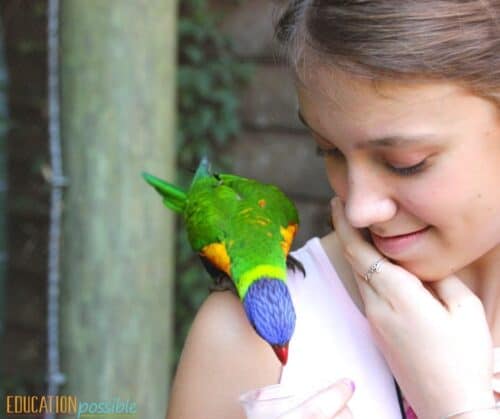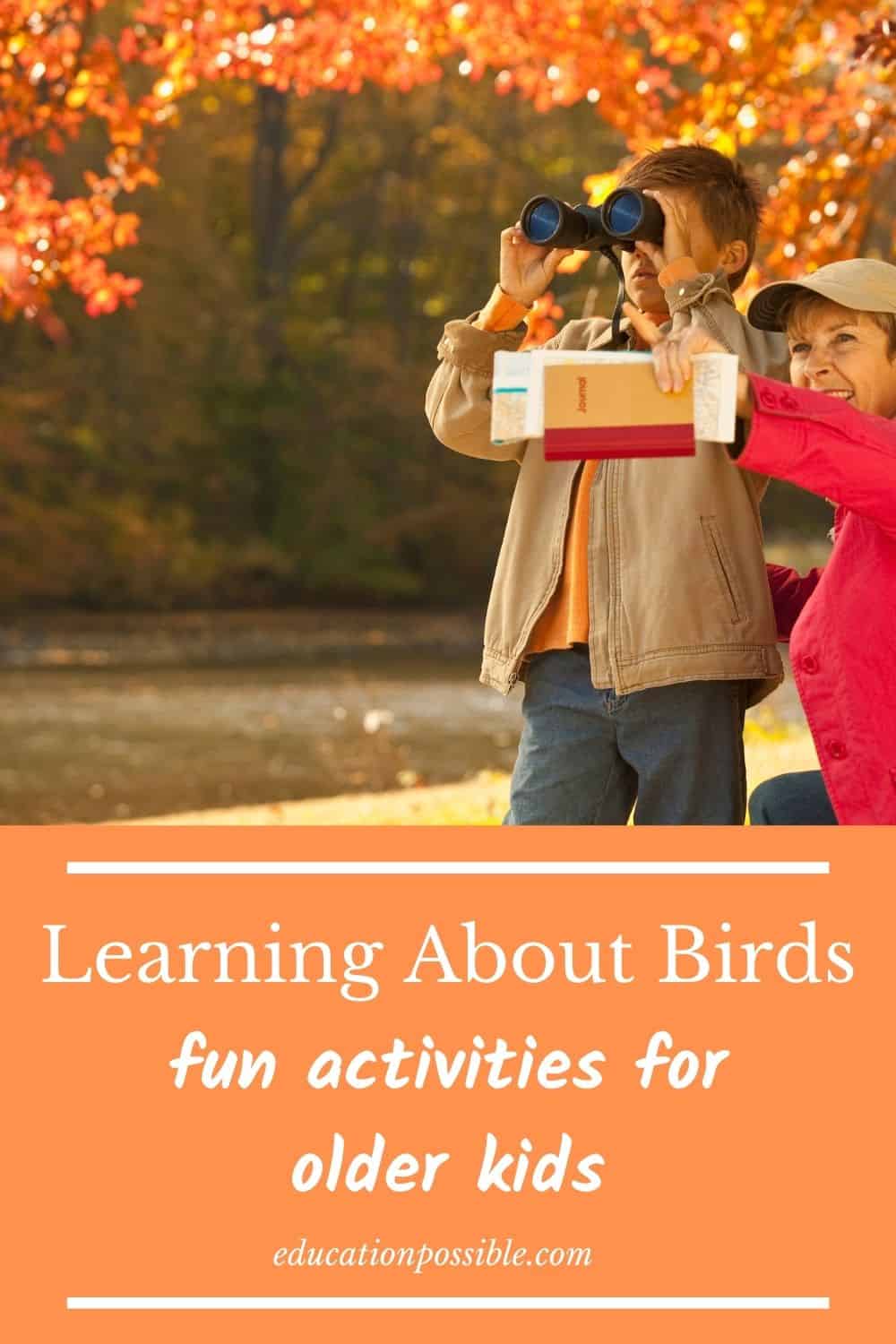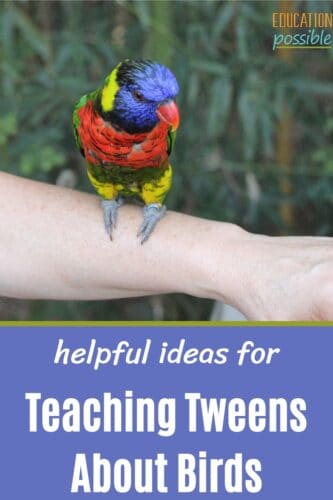Engaging Ideas For Teaching Kids About Birds
If you’re studying zoology in science, now’s the time for teaching kids about birds. With over 9,000 species in the world, you’ll never run out of creatures to study.
The best way for kids to learn about birds is to view as many as you can. And make sure you’re taking the time to work on projects that will get them excited and keep them engaged.
Keep reading for some ideas you can use in your homeschool to teach your middle schoolers about these majestic flying creatures.

Any links in this post may be affiliate links. See my disclosure statement.
Learning About Birds
The first thing you’ll want to do when you start your bird studies is make sure your kids understand some basics about them. Things that make them unique compared to other animals.
Ornithology, the branch of zoology focused on the study of birds, is actually an easy science topic to get kids excited about, mainly because they’re animals they see every day. In fact, your tweens may know more about these creatures than you think.
But, before you look at specific types of birds, teach your middle schoolers anything they need to know about them. Things like, why do birds have beaks, what are their bones made of, how do most birds fly, how many species are there, etc.
Once they understand the key characteristics of these creatures, they’ll have an easier time digging deeper into specific breeds.
How To Teach About Birds
The easiest way to continue teaching kids about birds is through observation. This can be done outside, if the weather permits, or inside, through the windows. Have your kids spend some time quietly sitting or standing, just watching what flies by.
Have them note the different birds they see. They can use a spiral notebook or birding journal to write down the names of the birds or their descriptions if they aren’t sure what kind of bird it is. If your tweens are more artistic, they could draw the creatures instead.
They can use a bird guide to help them identify the birds they see.
Then, spend some time together doing some further research. Here are some things you could study about each of the birds you found:
- scientific and common name
- migratory pattern
- distinguishing marks
- unique facts
- song
- diet
Once they’re done, your older kids can take this information and either write it down on in a notebook, on a bird study notebooking sheet, or turn it into a visual presentation. The more often you go birdwatching, the better you’ll get at identifying birds.
Bird Activities for Middle School
The best way for kids to learn anything science related is through interesting, hands-on activities. Most kids learn best when lessons include a physical component, along with book reading and lectures.
Using the tips mentioned above as starting blocks, add some ideas below to your next bird-themed lesson plans to engage your older kids.
Help birds build their nests
Your kids may have not noticed, but birds absolutely love decorating their nests with all types of material. Encourage them to contribute by gathering the following materials:
- Yarn
- String
- Stuffing from an old pillow or cushion
- Hair from your brush
- Dryer lint
Once they have everything, have them put it in a mesh bag or plastic carton with the top cut off. Then, keep an eye out for birds picking from it. Have your kids make a hypothesis as to which materials they think the birds will choose and why. After a couple of days, see who was right.
You could also go on a hunt to see if you can find a nest that used some of the donated materials.

Make a birdseed feeder
If your tweens haven’t made birdseed feeders since they were in elementary school, now’s the time to make one. Remember how fun it was collecting pine cones and smearing them with peanut butter? Your kids don’t have to stick with this classic – there’s a wide variety to choose from. Encourage them to be creative.
First, have them research different types of handmade feeders and choose one they think will attract the most birds. After they’re made, everyone can vote on whose creation they think will get eaten first and why.
Then, it’s time to put it out in the yard and see what happens.
As part of your science lesson, have your tweens write down the reasoning behind their choice, as well as the process they followed to create their feeder. Then, they can see how theirs compared to everyone else’s.
Make your yard bird friendly
Climate change is making things more difficult for flying creatures, so during your bird study, take steps toward making your yard more friendly for them.
First, do some research into what birds need in a habitat. You’ll need to consider native plants, what type of food or shelter can you provide, and the types of birds you’re trying to attract. Once you have a plan, go out and make the additions/changes to your yard.
Name that bird call
An interesting topic to add to your lesson plans is vocalization. Learn things like, what sounds do various birds make and why? What’s the difference between a song and a call and why is one usually longer than the other? Learning about a bird’s sounds will teach kids more about the species, plus it will help them with identification.
After your tweens have learned the basics of a bird’s sound, play a game of “who can name the bird call?” Have everyone sit down and listen as you play bird sounds. Kids can either shout out the answer or they can write them down and to review together.
Give bonus points to anyone who can imitate the sound!

Go to an aviary
Lots of zoos have separate aviaries included, so during your study of birds, head to your local aviary to spend time with them. Many of them offer feeding opportunities, which will help your tweens get up close and personal with a variety of birds.
Have your kids take pictures of the different species so you can do some research and identification when you get home.
Play a game
There are a few different board games you can use as part of your lesson plans to help kids learn about birds and get better at recognizing them.
- Bird Trivia Game “What Bird Am I?” – This game was designed to put your bird knowledge to the test. It has three levels: novice, intermediate, and truly serious birders. With 300 beautiful bird photos and an easy-to-use scoring system, you and your tweens will have a blast playing this game. And as a bonus, you could easily use the cards as the main part of your lessons.
- Bird Bingo Board Game – This bird BINGO game features actual pictures of many species of birds. Your kids will learn how to recognize birds while playing one of the most loved games – BINGO!
- Wingspan Board Game – Tweens will forget they’re even learning about birds with this board game. Each bird featured extends a chain of powerful combinations in each of 3 unique habitats. They will get to build an engine to gain food, lay eggs, and draw from 170 uniquely and beautifully illustrated bird cards.
Build a shelter
Building a birdhouse is one way to contribute to the safety and security of the bird community. It’s also the perfect project to go along with a lesson on shelter. Kids can build one out of materials you already have in your home or you can purchase one like this DIY bird bungalow.
Teaching kids about birds can be a fun and ongoing adventure. With no shortage of birds to study, there’s always something new to learn about them.

Helpful Bird Guides
If you’re studying birds in your homeschool, you will definitely want to get a bird guide to help you identify the birds in your area. Here are a couple of our favorites.
- The Burgess Bird Book reads like a chapter book. It introduces readers to a variety of birds in story fashion, teaching them tons of information along the way.
- Backyard Birds is a wonderful guide for beginners. Full of beautiful art, it will introduce students to the widely used Peterson Identification System.
- The Sibley Guide to Birds is a fantastic tool for learning more about birds. It’s full of colorful illustrations, habitats, maps, and information.
- National Geographic Kids Bird Guide of North America is full of fun facts, maps, and activities all related to 50 of North America’s most popular birds.
More Bird Lesson Ideas
If you need even more ideas to round out your lesson plans, check these out.
- Lessons about birds don’t have to wait for warm weather. Use these winter bird activities during the colder months.
- Use these fun projects as part of your science lessons.
- If you need more activities about birds, here are some more that are perfect for middle schoolers.

